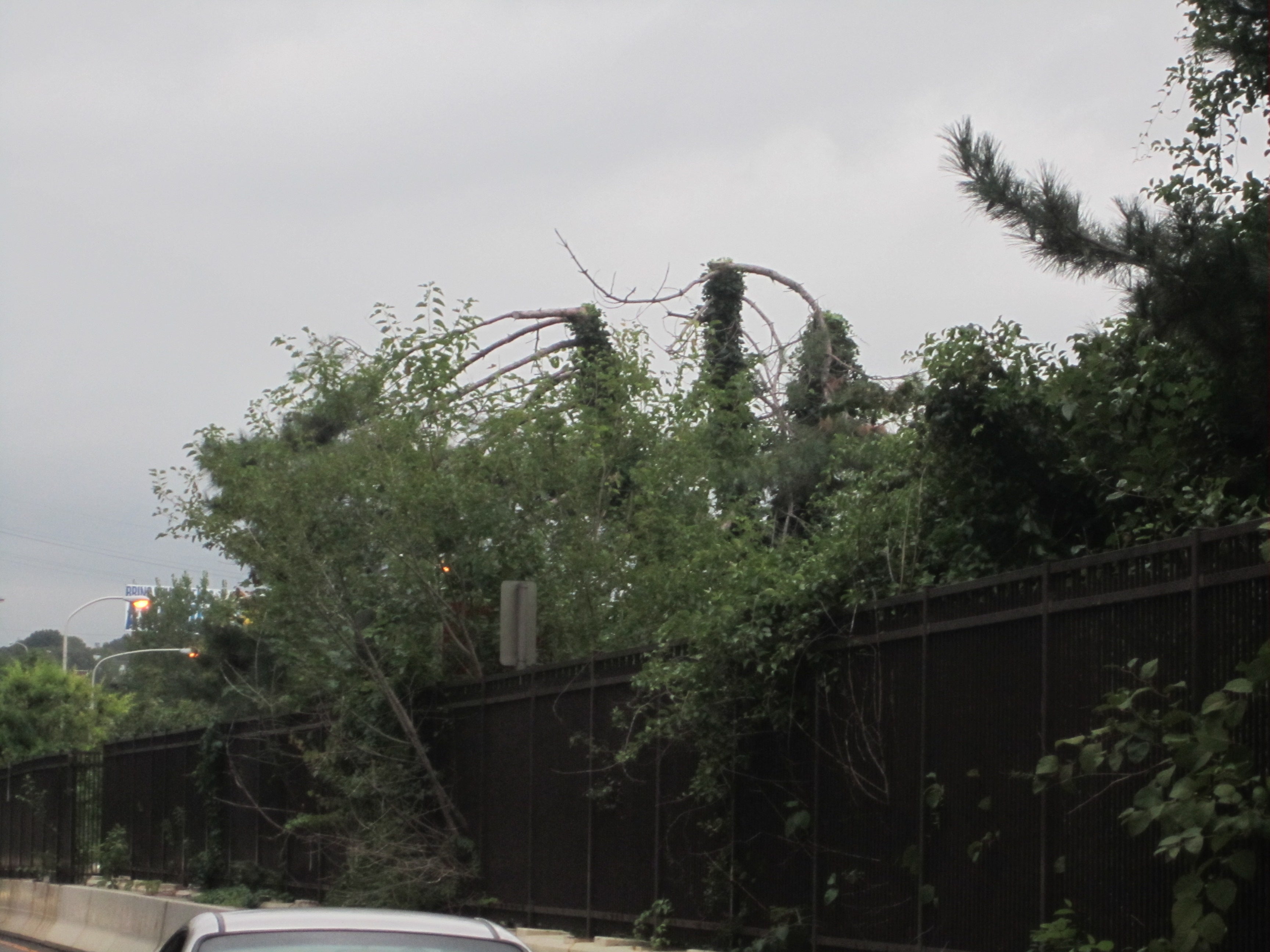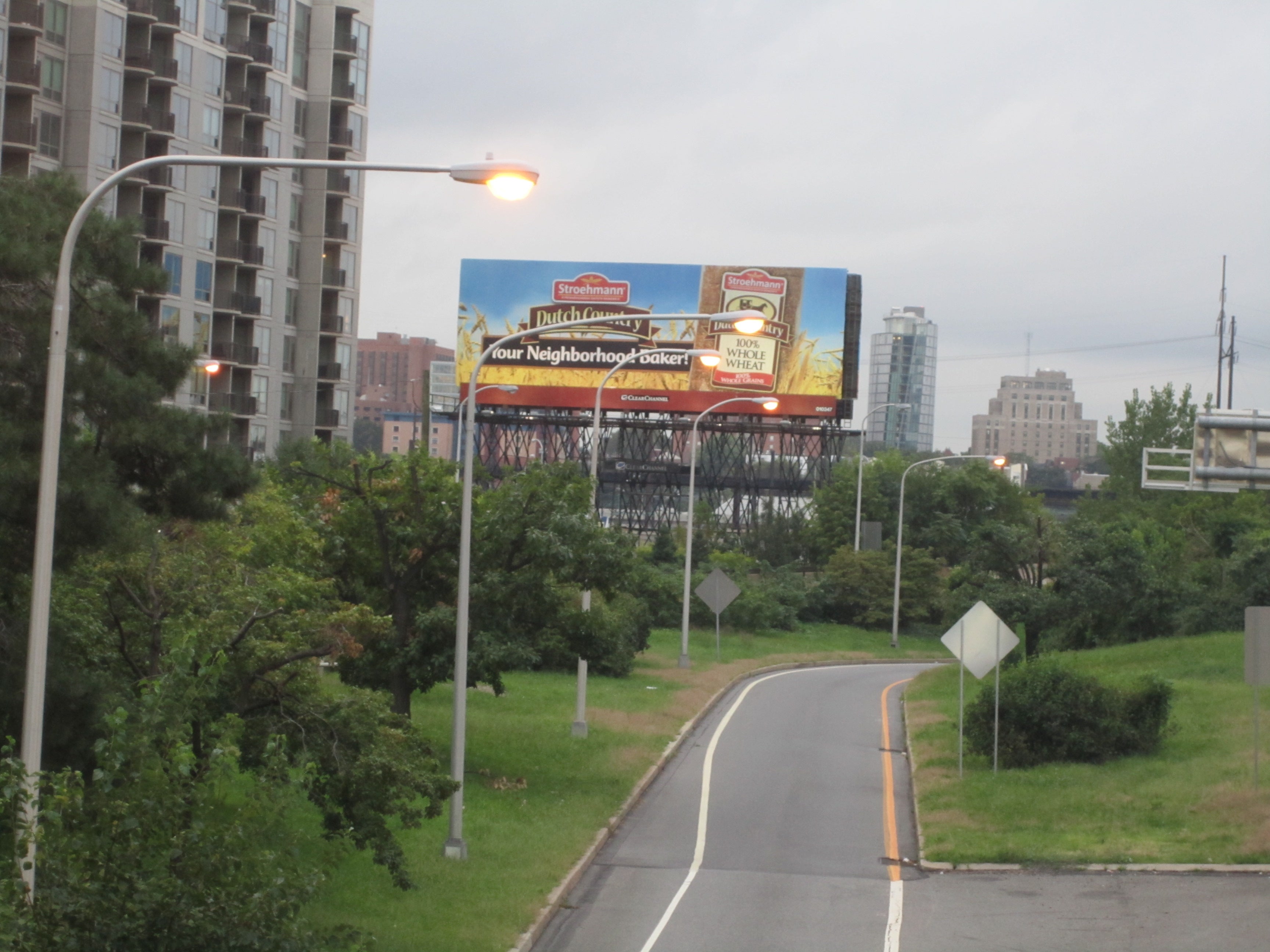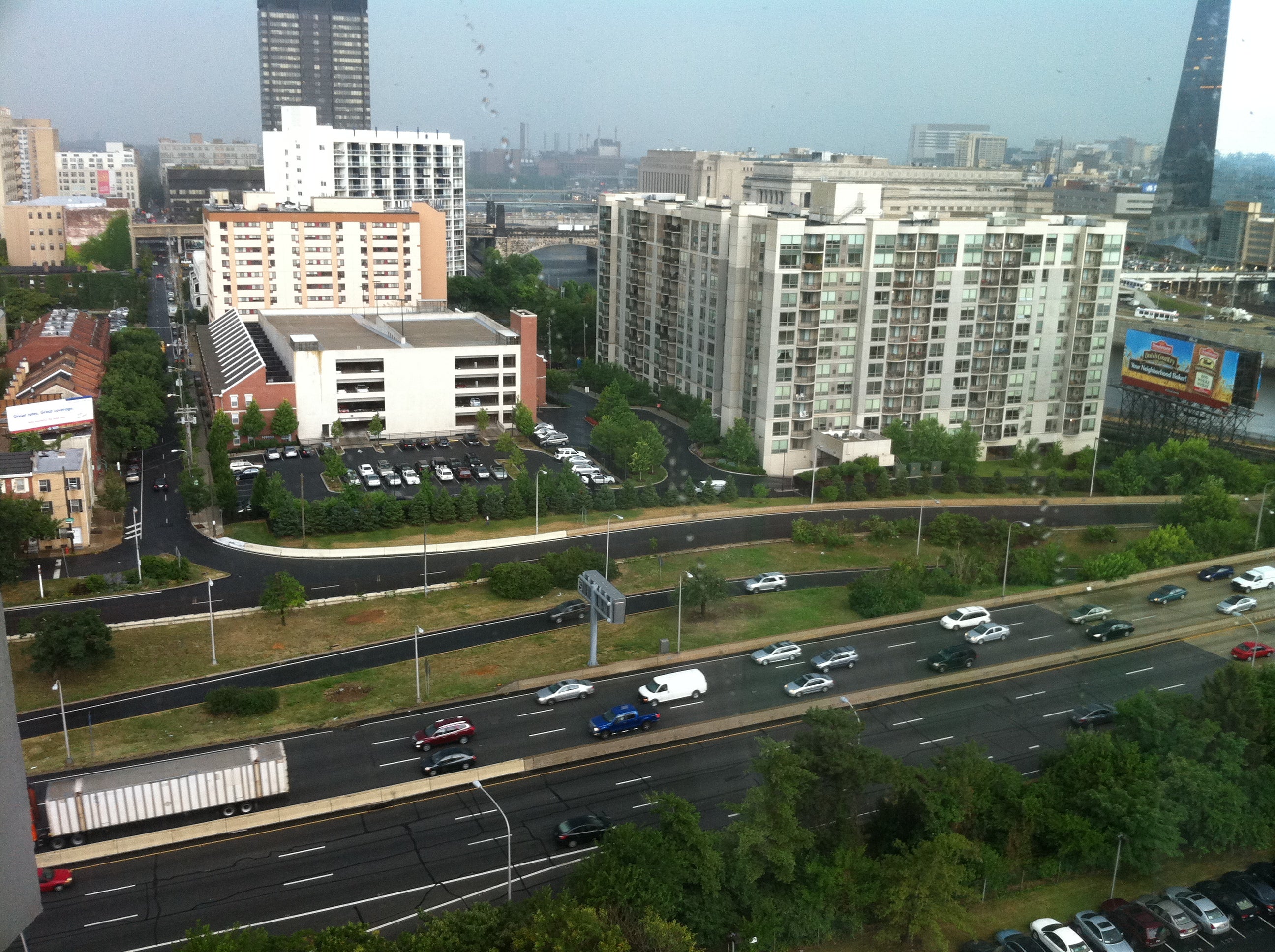SCRUB: How trees make way for billboards.
This report was produced by SCRUB, the Public Voice for Public Space
By Frances V. Ryan and Sabrine Tribié
This summer, SCRUB was contacted by a distraught Philadelphian who observed the cutting of a large swath of greenery along the south side of the Vine Street Expressway between 23rd street and the Schuylkill River. It is an area that many Philadelphians can see from their high rises near the Art Museum and it is busy with traffic as cars head to the nearby interchange of interstates 76 & 676. Trees and bushes were completely removed, some trees were harshly “topped”. Our concerned citizen made inquiries and confirmed what was painfully obvious… the cutting was done in order to enhance the visibility of a huge billboard soaring above the roadway.
The cutting of trees to clear a view of billboards is becoming a hot button issue. Outdoor advertising companies want to protect their business as well as the businesses being advertised. Nearby residents want to protect the trees, their view and the environment. Legislative and legal battles have erupted in many states and municipalities. As the value of trees becomes more evident, more conflict is guaranteed.
Outdoor advertisers argue that they have the right to have their billboards seen. While billboards are generally erected on private property, the trees that may block the view of the advertisement often grow in the right of way. As such, the trees belong to the government entity responsible for the right of way and thus, the public. By insisting on view zones, outdoor billboard companies are effectively claiming property rights in public property.
Research is mounting that trees, besides being beautiful, may actually make roads safer. The Next American City published an article on October 1, 2011 entitled “Trees in Transit” citing the many positive attributes of trees:
These incredible organisms clean our air and water, provide valuable habitat for wildlife, increase our property values, and make us feel happier through their beauty. They also seem to make urban roads safer. Most of us don’t think of trees as infrastructure, but in an urban context they are just that. Research indicates that they can play a powerful role in traffic calming, especially through their impact on three vehicle-related risks: speeding, road rage, and pedestrian/bicyclist injury.
Outdoor advertisers counter that billboards are good for local businesses and bring prosperity into states and municipalities. Yet, no traveler goes to a destination to see billboards but rather is drawn to places that are historically significant, aesthetically pleasing and unique. Clearing wide billboard view zones negatively impacts these characteristics.
In many states and municipalities, outdoor advertising companies have gained ground in the tree-cutting wars. Georgia had been known for its success against the companies. Conservation groups, particularly the Garden Clubs of Georgia successfully promoted the notion that billboard companies must pay the state for the value of the cut trees. Furthermore, the law in Georgia severely restricted the size of the viewing area allowed and also prevented the cutting of older trees. This year, however, after a relentless campaign focused on the need to improve the economy, the outdoor advertising companies in Georgia gained the upper hand and secured the passage of new legislation, easing many of these restrictions. Clear cutting around billboards on miles of Georgia state roadways has greatly increased and a credit provision in the legislation means that the outdoor advertising companies will pay less for the right to cut the trees. Conservation groups are fighting back with a lawsuit.
Often, the billboard- versus- tree conflict arises in the context of cities and towns attempting to engage in beautification efforts. Los Angeles planted palm trees in the median of Century Boulevard to improve appearances before the 2000 Democratic Convention. An outdoor advertising company claimed fewer motorists could see their signs and sued the city. Six years of litigation later, the California Supreme Court recognized the right of the local government to beautify roadways by planting trees, regardless of how they affected the view of adjacent property. Florida, on the other hand, gives outdoor advertisers compensatory rights in public assets. Local governments who refuse to allow a football field sized viewing zone around a billboard must pay the owners for lost revenues. Nonetheless, outdoor advertisers sought even more concessions in Florida this year. They pushed for legislation that would make their participation in certain mitigation efforts strictly voluntary. For now, this attempt is stalled after resistance from conservation groups.
In 1987, Virginia Beach placed a ban on the erection of new billboards. Meanwhile, dozens of crape myrtle trees were planted along a major highway. As the trees grew, they partially blocked views of existing billboards. The affected outdoor advertising company pushed Virginia Beach for permission to cut the trees down. When Virginia Beach refused, the outdoor advertisers went to the state legislature which then granted jurisdiction of these matters to the state highway department, which permitted removal of the crape myrtles. In an effort to create goodwill among outraged garden clubs, the billboard companies transplanted the trees elsewhere.
Legislation and lawsuits aside, outdoor advertising companies are sometimes accused of “rogue” tree cutting and poisoning of trees. In Tallahassee, a former employee of an outdoor advertising company recently filed suit claiming that he was ordered to illegally trim and poison dozens of trees from 2009 to 2011. He also claims that he was ordered to remove and illegally bury hazardous materials prior to visits from state inspectors. When he told the company he would no longer illegally trim or poison trees, he claims he was fired. The company denies the allegations. The plaintiff’s attorney states that he has witnesses to corroborate the claims. Meanwhile, state and local officials are investigating.
Outdoor advertising companies gain legislative support by establishing a strong relationship with lawmakers. The companies’ often contribute to lawmakers’ campaigns and offer them and their favorite charities free advertising space. They can appear to be good corporate citizens by donating space for public service messages on billboards that otherwise might be standing empty. During tough economic times, they stress their role in promoting business.
The public is often unaware of the extent of the companies’ influence with law makers or their tree cutting activities. However, once awareness is raised, the outcry can make a difference in what is accepted by the public. Recently, North Carolina was pushed to ease restrictions on billboards. However, a telephone poll conducted by the North Carolina League of Conservation Voters, showed that more than 80% of those surveyed opposed removing more trees so that billboards could be seen for longer distances. Furthermore, there was virtually no support for having the state tell local communities where and what kinds of billboards can be put in their boundaries. As for the argument that billboards are good for the economy, 90% of those surveyed said the lawmakers should focus on creating jobs rather than weakening billboard restrictions and that opinion was the same among Republicans, Democrats and Independents.
In 1983, the Pennsylvania Legislature enacted the Highway Vegetation Control Act which provides that “the owner of any devise along an interstate or federal aid primary highway which is screened by vegetation” may apply for a permit to take “remedial action.” If the permit is approved, the applicant may raise (or lower) the sign to reduce conflict with vegetation, prune, trim or relocate the vegetation. The fee to apply for the permit is $90 but the application can apply to more than one devise.
Often, as in the case of the billboard along the Vine Street Expressway, there is confusion about who has jurisdiction over a particular right of way. There, the City of Philadelphia claimed not to be responsible for supervising tree cutting in this right-of-way and PennDot states it did not issue a permit. Thus, the bushes and trees were apparently cleared away without supervision of a governing body, no payment of a permit fee and no provisions made for replanting or compensation to taxpayers for the value of the trees and bushes removed. This scenario does not serve Mayor Nutter’s goal of making Philadelphia the “Greenest American City”.
Outdoor advertising companies are tough opponents. Protecting trees and the public space requires equal toughness. As Joan Brown of The Garden Club of Georgia stated, “Join forces with large environmental groups. Be diligent. Get to know your legislators.” Citizens and policy makers who wish to beautify their state or city by increasing the numbers and types of trees in a locale need to be aware that “going green” may cause conflicts with the billboard industry. Becoming educated about the issues and standing firm about protecting trees and our public space is crucial.
For more information on SCRUB please see www.publicvoiceforpublicspace.org or call 215-731-1775
WHYY is your source for fact-based, in-depth journalism and information. As a nonprofit organization, we rely on financial support from readers like you. Please give today.






